The Courier had been developed by Dr. Otto C. Koppen and Dr. Lynn Bollinger from initial experimental work in the late 1940s. It had been designed as a fast, four-seat, light aircraft with excellent short-field performance, a characteristic later designated STOL performance. Fitted with a 260 hp Lycoming GO-435-C2B2, the cantilever monoplane had full-span leading edge automatic slots and a very generous, Fowler-type, slotted flap covering 74% of the trailing edge of the wing.
Interceptor blades were provided on the wing for good lateral control even beyond the stall. An all-flying horizontal tail was fitted. These devices enabled it to take off or land in 225 ft (68.6 m), or in 495 ft (151 m) over a 50 ft (15 m) obstacle, and to maintain a minimum flying speed of 30 mph (48.3 kmh) in powered level flight. The fuselage in the cabin area and forward to the engine mounting was a metal-covered steel tubular structure. All other components were of typical stressed-skin construction and were made of duralumin.
Components for three aircraft (c/ns 001-003) were made and shipped to Helio Aircraft where they were assembled into complete aircraft. The fourth set of components, c/n 004, was assembled by Fleet and registered CF-IBF. At this time Fleet encountered financial difficulties and the Helio agreement was cancelled, but two more aircraft sets (c/n 005 and 006) of parts rather than components were supplied to Helio for assembly. While Helio refered to c/n 001-006 as Canadian-made, actually CF-IBF was the only one machine completely assembled and flown in Canada.
CF-IBF was first flown at Fort Erie by Dennis H. Byron on February 1, 1955. In the summer of 1956 it was evaluated by the Evaluation Planning Group, Army Headquarters, with testing at Ottawa, Gagetown, and Wainwright. On July 4 and 5, 1956, company pilot Oldand, and Lieutenant G.C. Walker flew wire laying tests at Gagetown. It was sold in western Canada and still later exported to the USA. It was registered N4200B between April 9, 1971 and September 2, 1976."
